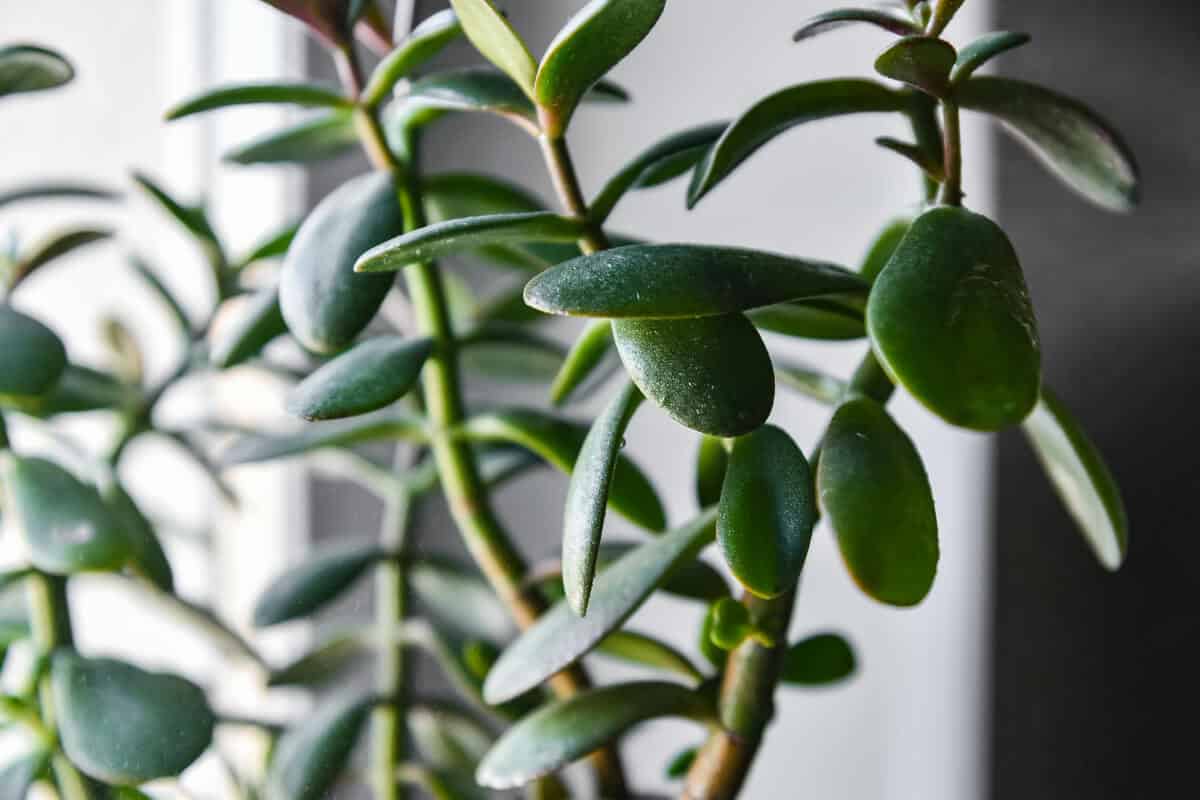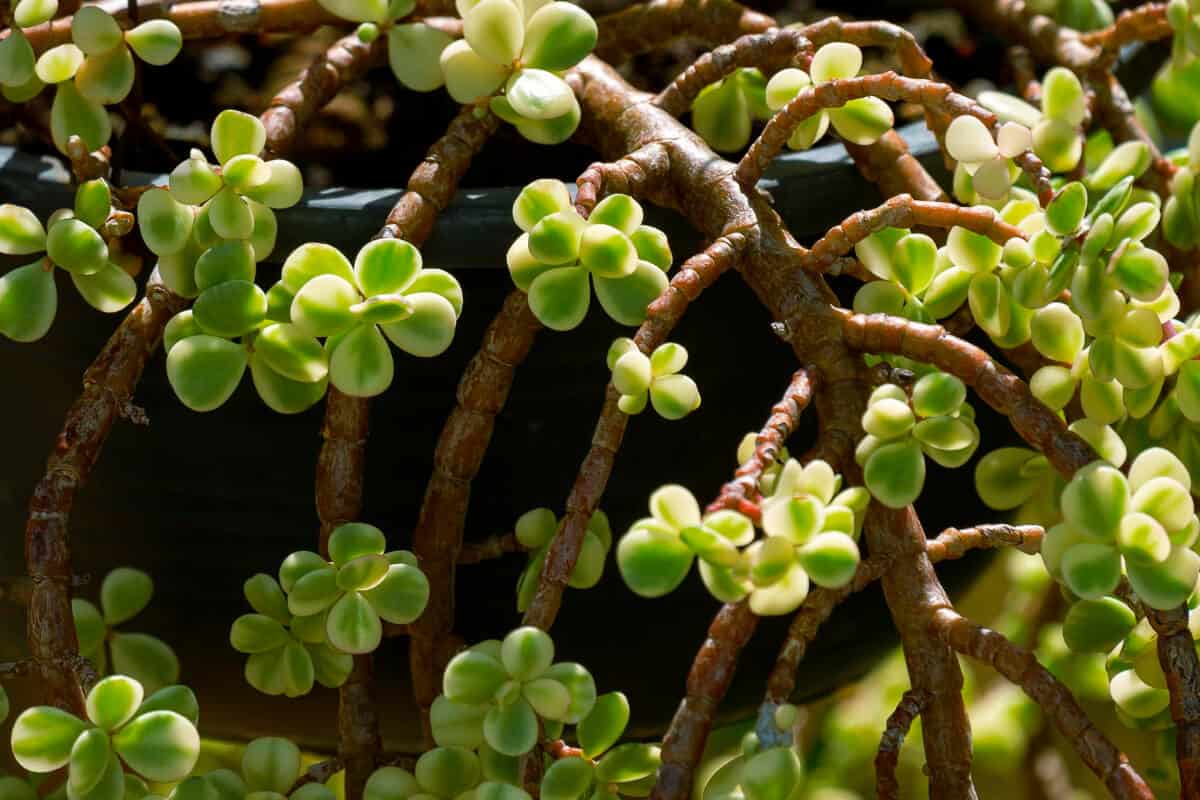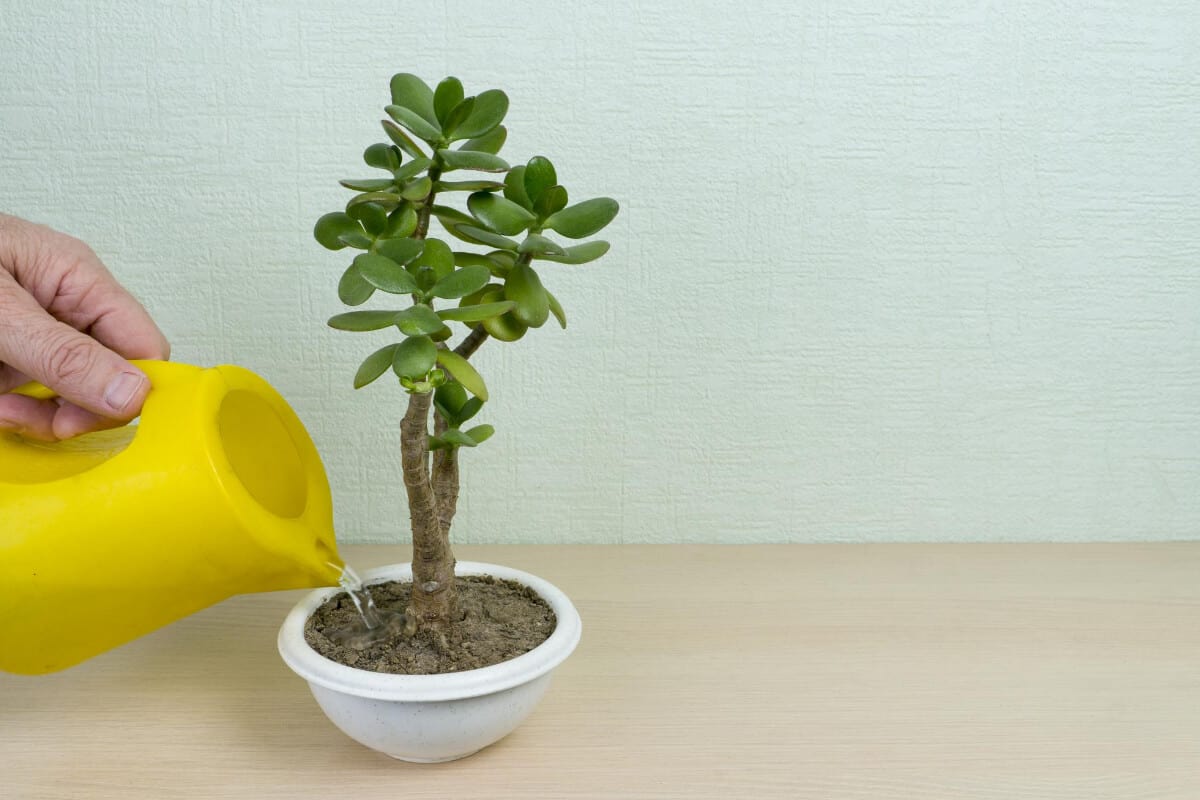Ever noticed your jade plant looking like it’s reaching for the sky? Many plant parents face the challenge of leggy jade plants, those once-compact succulents that suddenly seem to be all stem and sparse leaves.
I’ll show you how to fix a leggy jade plant and restore its lush, compact beauty. We’ll explore the causes of legginess, effective pruning techniques, and preventive measures to keep your jade thriving.
Ready to make your stretched-out succulent into a bushy beauty? Let’s learn how to give your Jade plant the glow-up it deserves.
- Related article: Jade Plant Care
6 Key Takeaways on How to Fix a Leggy Jade Plant
- Jade plants become leggy due to insufficient sunlight and improper watering habits.
- Moving your jade plant to a brighter location helps prevent leggy growth.
- Regular pruning encourages bushier, more compact growth in jade plants.
- Using grow lights can supplement low natural light for jade plants, especially in winter.
- Prune leggy stems and branches to maintain balance and prevent the plant from becoming top-heavy.
- Jade plants can be easily propagated using cuttings taken during pruning.
Why Does a Jade Plant Get Leggy?

Jade plants become leggy because they don’t get enough sunlight, which they need to grow well.
These plants, known scientifically as Crassula ovata, come from bright, sunny places. When they’re kept in areas with little light, they stretch out towards the light, causing their stems to grow long and thin with fewer leaves. This makes them look straggly.
Also, how you water them can make the problem worse. If you give them too much or too little water, it can lead to unhealthy growth. This makes it easier for the plant to become leggy.
How to Fix a Leggy Jade Plant
A leggy jade plant is bad because it results from insufficient light, causing weak, stretched growth that makes the plant unstable and prone to falling over or breaking. Here are several actions you can undertake to fix your leggy jade plant:
1. Move Your Plant to a New Location
If your plant appears a bit leggy, try moving it to a window sill, or close to a window so that it has direct access to light. Make sure the window, transparent wall, or door you choose gets sufficient daily sunlight. It’s also important to choose the ideal soil for jade plants.
2. Place Your Jade Plant Outdoors Daily
If you have a space outside you house, you can also consider rotating the position of your plant by alternating through indoors and outdoors.
You can choose to put it on your garden, porch or patio for several days during the week. However, make sure to keep an eye on pests and plant diseases that you might carry back indoors with your plant.
This might be another problem that can arise in the future.
3. Pinch and Prune
It’s simple to prune the leggy stems of your plant. This will not only stimulate denser, bushier growth but improve the aesthetics of the plant as well.
Trim off thin foliage or sickly-looking branches and stems. Thin stems should be pruned as they will not be able to support the weight of fleshy foliage.
4. Install a Grow Light
LED and fluorescent lights provide an excellent alternative to insufficient light. For example, if you live in an apartment without much light and a balcony, consider using a grow light for your houseplants.
This is also a great option if you are cultivating a jade plant in an office setting. They are particularly at risk of becoming leggy in the winter.
You’ll find grow lights available in all sizes to fit any situation and budget. You can find them at your local plant nursery or easily buy them online on Amazon.
5. Reduce the Environmental Temperature
Jade plants will grow more rapidly in warmer climates and temperatures. While its growth will slow down when it’s cold.
If you are having difficulty providing a good light source, move your plant to a cooler location. This will slow the etiolation process.
How to Prune a Leggy Jade Plant
The jade plant is a tree-like plant that potentially will continue to grow taller in the proper environmental conditions. It can grow tall and top-heavy, placing it at risk to fall over one day.
Often, a plant’s single trunk is unable to support the total weight of a top-heavy plant. So, what can we do about this?
Prune your plant to maintain a weight that is evenly distributed. Most jade plants will need to be pruned yearly.
Begin pruning when the plant is still young and smaller in size. This will stimulate your plant to branch out in evenly and will enhance its look to make for a real bushy plant.
How to Prune a Leggy Jade Plant

The jade plant is a tree-like plant that potentially will continue to grow taller in the proper environmental conditions. It can grow tall and top-heavy, placing it at risk to fall over one day.
Often, a plant’s single trunk is unable to support the total weight of a top-heavy plant. So, what can we do about this?
Prune your plant to maintain a weight that is evenly distributed. Most jade plants will need to be pruned yearly.
Begin pruning when the plant is still young and smaller in size. This will stimulate your plant to branch out in evenly and will enhance its look to make for a real bushy plant.
How to Prune a Small Jade Plant
For plants smaller than 6 inches in height, just top off the trunk. New leaves will sprout from your cut point in a few weeks.
- When to Prune – Prune your plants in early spring, just before they start to grow more.
- Tools to Use – A sharp pruning shears or knife works best. Make sure to clean them with alcohol first to keep your plants healthy.
I have been using Bypass Pruning Shears for a long time to professionally prune not only my Jade plant but also other plants in my garden. The sharp pruners come with an adjustable feature for any hand size, which I find very convenient.
Here’s how I prune:
- Pinching Back Stems – I start by pinching the tips of the stems. This helps the plant grow more branches. It’s especially good for new plants.
- Getting Rid of Damaged Parts – I then cut off any parts that are hurt or too long. I make sure not to take off more than a third of the plant. This keeps it from getting too stressed.
- Shaping the Plant – I trim extra growth to keep the plant looking neat and to help it grow new leaves where I want.
This way, my small plants stay healthy and grow just the way I want them to.
How to Prune Tall Jade Plants
Examine your plant closely and search for brown stem rings. These should be located approximately ¼th of an inch from the branch’s end. Cut through the ring with sharp, clean, pruning shears or a garden knife.
Pruning your on a regular basis will make your jade plant bushy and more attractive.
How to Prune Jade Plants to Encourage Branching
To encourage a bushier Jade plant, you can prune the top of leggy plants up until what is called a leaf scar. The area of a plant that has brown rings around the stem is called a leaf scar. This process will cause the growth of fuller lateral branches.
Also, remove leaves that are sprouting from the trunk. This will stimulate the fresh growth of branches from these points. Never remove more than 2 or 3 leaves at any one time.
How to Prune Jade Plants That Are Overgrown
If you have an overgrown jade plant with too many branches or dead leaves, it’s time for pruning. Remove dried-out, diseased, damaged branch tips or dead stems.
Do not cut the main trunk. Remove yellowing, shriveling, or spotted foliage along with other overgrown sections of the plant.
Identify branches growing at unusual angles and trim them off. If branches are congested and blocking sunlight from the trunk, remove excess branches.
Jade Plant Pruning Tips
Pruning a jade plant is an essential part of its care and can be easily mastered with the right techniques. In this gardening guide, you’ll learn how to keep your jade plant healthy, vibrant, and well-shaped.
1. Pruning Tools for Jade Plants
Use sharp tools that have been properly cleaned and sterilized. Sharp shears or bonsai pruning shears are the recommended choice. By sterilizing them, you avoid spreading disease to your plant.
2. When to Prune Jade Plants
Prune your jade plant at the beginning of spring before the growing season takes off. This is particularly important for jade plants that are cultivated outdoors.
3. Save Jade Plant Cuttings
Don’t toss out Jade plant cuttings after pruning. The Jade Plant is easily propagated, so these cuttings can be used for new Jade plants to keep and gift.
4. Don’t Prune Jade Plants Too Often
Never prune more than one-third of the plant. Cut conservatively. Once you’ve pruned, there’s no going back.
How to Prevent Leggy Jade Plants

A leggy Jade plant is due to inadequate access to sunlight. The best way to prevent your Jade plant from becoming leggy is to guarantee your plant receives sunlight several hours daily.
Place your plant in or near a window to provide natural light. If this is impossible, use an artificial grow light.
Apart from providing access to adequate light, improve your Jade plant care. Water your plant on a schedule and add a bit of fertilizer occasionally.
The Jade plant is not a big feeder. Get a fertilizer formulated specifically for succulents and follow the manufacturer’s instructions for application.
Fixing Leggy Jade Plants Final Thoughts
Prevention is always the best solution. it’s better to act early so your Jade plant never becomes leggy.
Provide your jade plant with hours of sunlight. It will reward you with beautiful dense growth that is aesthetically pleasing.
If your Jade plant is already leggy, follow these basic tips to improve your plant’s health and appearance.
To learn more about Jade plants, check out these other articles:



